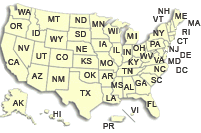|

PUBLICATIONS
Annual Water Data Report
USGS Publications Warehouse
USGS IN YOUR STATE
USGS Water Science Centers are located in each state.

|
Comparison of Benthic Macroinvertebrate Response Models to Urban Intensity in Nine Metropolitan Areas of the Conterminous United States
Annual meeting of the North American Benthological Society
By T.F. Cuffney1, G. McMahon1, I. A. Waite2, J. A. May3, and R. A. Brightbill4
1 U.S. Geological Survey, North Carolina Water Science Center, 3916 Sunset Ridge Road, Raleigh, North Carolina 27607
2 U.S. Geological Survey, Oregon Water Science Center, 2130 SW 5th Avenue, Portland, OR 97201
3 U.S. Geological Survey, California Water Science Center, Placer Hall, 600 J Street, Sacramento, CA 95819
4 U.S. Geological Survey, Pennsylvania Water Science Center, 215 Limekiln Road, New Cumberland, PA 17070
Abstract
The effects of urbanization on macroinvertebrates were studied in nine metropolitan areas (Boston, MA; Raleigh, NC; Atlanta, GA; Birmingham, AL; Milwaukee-Green Bay, WI; Denver, CO; Dallas-Fort Worth, TX; Salt Lake City, UT; Portland, OR) as part of the U.S. Geological Survey’s National Water-Quality Assessment Program. Regression models relating responses (i.e., ordination site scores and metrics) to urban intensity, population, infrastructure, and land-cover variables were developed for each metropolitan area. These models were compared on their ability (R2) to depict changes along the urban gradient and to predict responses in other metropolitan areas (e.g., using the Atlanta, GA model to predict changes in Raleigh, NC). Ordination models derived from first-axis ordination (CA or NMDS) site scores were more strongly related (R2 = 0.49-0.82) to urban intensity than were models based on metrics (R2 = 0.14-0.49). Multiple regression models relating land cover, infrastructure, and population density to ordination site scores and metrics tended to be better predictors (multiple R2 = 0.44-0.91) of responses than were models based solely on urban intensity. Ordination models were better able to predict responses in other metropolitan areas than were models based on metrics provided the metropolitan areas had similar invertebrate assemblages.
Citation:
Cuffney, T.F., McMahon, G., Waite, I.A., May, J.A., and Brightbill, R.A., 2008, Comparison of Benthic Macroinvertebrate Response Models to Urban Intensity in Nine Metropolitan Areas of the Conterminous United States: Salt Lake City, UT, Annual meeting of the North American Benthological Society [abs].
|
For more information, contact |
To order printed copies |
North Carolina Water Science Center
U.S. Geological Survey
3916 Sunset Ridge Road
Raleigh, North Carolina 27607
(919) 571-4000
E-mail
|
|
|
